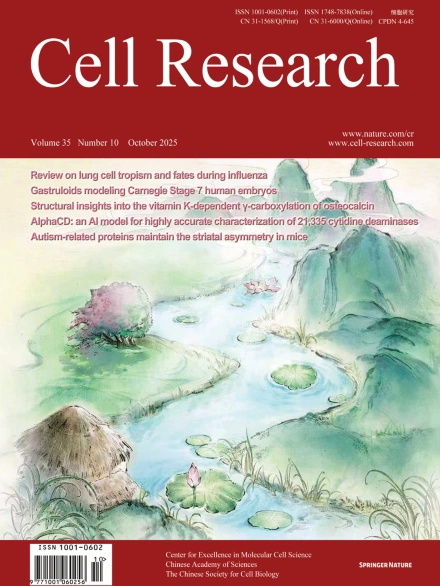
Advanced Search
Submit Manuscript
Advanced Search
Submit Manuscript
Volume 35, No 10, Oct 2025
ISSN: 1001-0602
EISSN: 1748-7838 2018
impact factor 17.848*
(Clarivate Analytics, 2019)
Volume 35 Issue 10, October 2025: 719-734
Establishment of human gastrulating stem cells with the capacity of stable differentiation into multiple gastrulating cell types
Mingqian Huang1,† , Mengqi Chen1,† , Gege Yuan1,† , Yiqiang Cui1,† , Bin Shen1 , Zhaode Liu1 , Bohang Zhang1 , Junqing Chen1 , Dingdong Chen1 , Shuangshuang Qiu1 , Yichun Zhang1 , Li Liu1,2 , Lianju Qin3 , Yunfei Zhu1 , Jiayin Liu3 , Hao Zhang1,* , Jun Wu4,5,6,* , Yan Yuan1,* , Jiahao Sha7,*
1State Key Laboratory of Reproductive Medicine and Offspring Health, Department of Histology and Embryology, Nanjing Medical University, Nanjing, Jiangsu, ChinaPluripotent stem cells (PSCs) have been derived from various species, but most culture systems stabilize only a single PSC type. By contrast, epiblast cells in vivo exist along a continuum and interact dynamically with both embryonic and extraembryonic cells, interactions missing in standard PSC cultures. This absence limits the self-organizing potential of PSCs and leads to disorganized tissue formation in teratomas. To address this, we developed a unified culture system that supports the stable differentiation of epiblast-like cells into multiple key human gastrulating cell types, collectively called human gastrulating stem cells (hGaSCs). hGaSCs, composed of endoderm-like, mesoderm-like, ectoderm-like, amnion ectoderm-like, and primordial germ cell-like cells, maintain a stable balance during long-term culture. In 3D culture, hGaSCs self-assemble into gastruloid-like structures (hGaSC-gastruloids) that model aspects of a Carnegie Stage 7 human embryo, including gastrulation and germ layer specification. Using hGaSC-gastruloids, we modeled the effects of valproic acid (VPA) on human gastrulation and uncovered molecular pathways underlying VPA-induced malformations. When transplanted into the seminiferous tubules, hGaSCs formed embryo-like structures, progressing through fetal tissue and organ development, unlike the disorganized growth seen in teratomas. In conclusion, hGaSCs provide a versatile platform to study human gastrulation, early organogenesis, developmental defects, and drug teratogenicity, with promising applications in tissue and organ generation from cultured stem cells.
https://doi.org/10.1038/s41422-025-01146-z